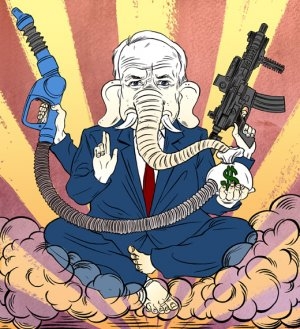
[Photos by JILL GREENBERG]
PHOTO DISTRICT NEWS: When The Atlantic called Jill Greenberg, a committed Democrat, to shoot a portrait of John McCain for its October cover, she rubbed her hands with glee.
She delivered the image the magazine asked for—a shot that makes the Republican presidential nominee look heroic. Greenberg is well known for her highly retouched images of bears and crying babies. But she didn’t bother to do much retouching on her McCain images. “I left his eyes red and his skin looking bad,” she says.
 After getting that shot, Greenberg asked McCain to “please come over here” for one more set-up before the 15-minute shoot was over. There, she had a beauty dish with a modeling light set up. “That’s what he thought he was being lit by,” Greenberg says. “But that wasn’t firing.”
After getting that shot, Greenberg asked McCain to “please come over here” for one more set-up before the 15-minute shoot was over. There, she had a beauty dish with a modeling light set up. “That’s what he thought he was being lit by,” Greenberg says. “But that wasn’t firing.”
What was firing was a strobe positioned below him, which cast the horror movie shadows across his face and on the wall right behind him. “He had no idea he was being lit from below,” Greenberg says. And his handlers didn’t seem to notice it either. “I guess they’re not very sophisticated,” she adds.
The Atlantic didn’t select the diabolical looking McCain for its cover. Greenberg is hoping to license that image to some other magazine (she negotiated a two-week embargo with The Atlantic so she could re-license images from the shoot before the election). MORE
WIKIPEDIA: “Karma” literally means “deed” or “act”, and more broadly names the universal principle of cause  and effect, action and reaction, which Hindus believe governs all life. It is believed that only beings that can distinguish right from wrong, such as adult humans, can accumulate Karma. Animals and young children are not responsible to accumulate Karma as they are incapable of discriminating between right and wrong. However, all sentient beings can feel the effects of Karma, which are pleasure and pain.[4] Karma is not fate; humans are believed to act with free will, creating their own destinies. According to the Vedas, if an individual sows goodness, he or she will reap goodness; if one sows evil, he or she will reap evil.
and effect, action and reaction, which Hindus believe governs all life. It is believed that only beings that can distinguish right from wrong, such as adult humans, can accumulate Karma. Animals and young children are not responsible to accumulate Karma as they are incapable of discriminating between right and wrong. However, all sentient beings can feel the effects of Karma, which are pleasure and pain.[4] Karma is not fate; humans are believed to act with free will, creating their own destinies. According to the Vedas, if an individual sows goodness, he or she will reap goodness; if one sows evil, he or she will reap evil.
THE NEW YORKER: Earlier this year, at a town-hall meeting at the Fantasy of Flight aircraft museum, in Polk City, Florida, Cindy McCain introduced her husband, the Republican Presidential nominee, with a speech about the nature of “the man.” There are, she said, many things “that make a great man, but being a good father and a good husband are most important to me.” She wore a tight black leather blazer over a black turtleneck, and her hair was styled stiffly in a ponytail. “I was working one day, one day a long, long time ago, in Bangladesh,” McCain said. “I stumbled upon a little girl in Mother Teresa’s orphanage, and she had a really bad cleft palate and she was sick and tiny and she was only ten weeks old. And I got to know her a little bit, and I was with her for quite a while. Mother Teresa—as only she could do at that time—prevailed upon me and said, You know, you can get help for her. You could, you can get her out . . . and, being a tenacious woman, I thought, Yeah! I can. Sure.”
McCain said that on the flight home from Bangkok she “realized that this child had chosen me and I could not give her up.” But there was something even more remarkable: “What you don’t know about this story is I didn’t tell my husband.” McCain smiled mischievously as she said that, and several members of the audience tittered. “I landed in Phoenix, Arizona, with this baby in my arms, and in front of a thousand reporters and a whole lot of people he whispered down to me and said, ‘Well, where’s she going to go?’ And I said, ‘I thought she’d come to our house.’ And he looked at her and he loved her just the way I have ever since. And I think that says a great deal about the man.”
 McCain’s account of bringing home a daughter without first informing her husband of her decision has become the core of the Cindy stump speech. She revisits the narrative routinely in her brief but frequent campaign appearances, and the Republican National Committee offered a version of it in a video that was played before her speech at the Convention last week. Almost every friend of the McCains with whom I spoke offered his or her own retelling of the tale. It is fact and fable: last month, the Christian Science Monitor reported that Mother Teresa was not actually at that orphanage at the time of Cindy McCain’s visit. (The McCain campaign subsequently revised the story on its Web site.) The story certainly helps to portray John McCain as openhearted and charitable. But it also happens to reflect the nearly separate lives lived by the two McCains, and the peculiar defiance that is characteristic of Cindy—a woman who claims to pride herself on being traditional.
McCain’s account of bringing home a daughter without first informing her husband of her decision has become the core of the Cindy stump speech. She revisits the narrative routinely in her brief but frequent campaign appearances, and the Republican National Committee offered a version of it in a video that was played before her speech at the Convention last week. Almost every friend of the McCains with whom I spoke offered his or her own retelling of the tale. It is fact and fable: last month, the Christian Science Monitor reported that Mother Teresa was not actually at that orphanage at the time of Cindy McCain’s visit. (The McCain campaign subsequently revised the story on its Web site.) The story certainly helps to portray John McCain as openhearted and charitable. But it also happens to reflect the nearly separate lives lived by the two McCains, and the peculiar defiance that is characteristic of Cindy—a woman who claims to pride herself on being traditional.
In her size-0 St. John skirt suits, and with her lacquered coiffures, Cindy McCain appears pampered and brittle. She was taken to a hospital with a sprained wrist after a fan shook her hand with too much gusto at a campaign event in Michigan last month. Her movements are quick and sharp—birdlike—and she often seems skittish, wary-eyed, and fidgety, fussing with her nails or her BlackBerry. McCain has said that she kept her phone with her at all times so that she wouldn’t miss a call from her son Jimmy, a marine, while he was in Iraq. But he returned in mid-February, and the BlackBerry remains in his mother’s hand much of the time. MORE
